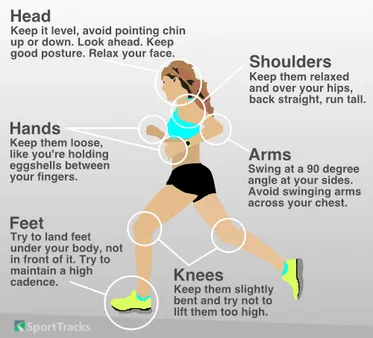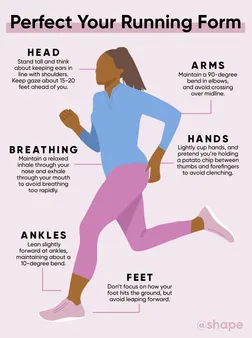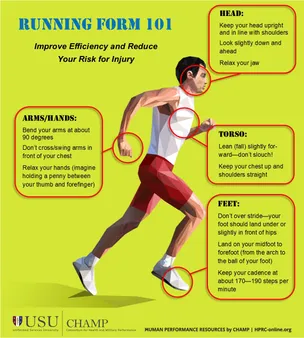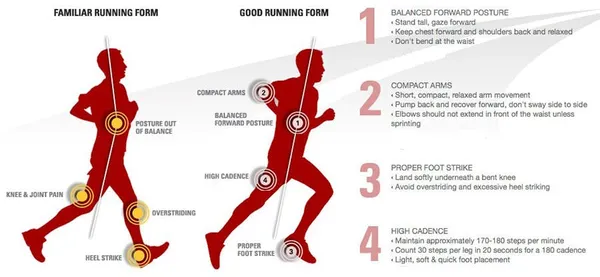Table of Contents
Running is an accessible and rewarding form of exercise, but achieving optimal performance and minimizing injury risk requires proper running form. Kizworld presents the ultimate guide to running form and technique, providing practical tips and techniques to help runners of all levels improve their running technique and unlock their full potential. Discover how to optimize your cadence, stride length, foot strike, core engagement, arm swing, and breathing technique for a more efficient, enjoyable, and injury-free running experience.
Know and Form With Running: A Complete Beginners' Guide
I. Running and Form: A Guide to Improve Your Running Technique
Running and Form: A Guide to Improve Your Running Technique
Use a Cadence of 180 Steps Per Minute
Maintaining a cadence of 180 steps per minute is key to efficient running. This higher step rate reduces the impact on your joints and increases your overall running efficiency. Shorter, quicker steps also make it easier to control your breathing and maintain a steady pace.
To improve your cadence, try listening to upbeat music with a tempo of 180 beats per minute. You can also use a metronome or a running app to track your steps and ensure you're hitting the target cadence.
Benefit | How to Achieve |
|---|---|
Reduced impact on joints | Take shorter, quicker steps |
Increased efficiency | Use a metronome or running app |
Easier to control breathing | Listen to upbeat music |
Learn more about the benefits of running
Shorten Your Strides
Taking shorter strides is another essential element of good running form. When your strides are too long, you're more likely to overstride, which can lead to injuries and decreased efficiency.
To shorten your strides, focus on taking quicker, lighter steps. Imagine that you're running on hot coals and need to minimize the time your feet spend on the ground. This will naturally shorten your strides and improve your running form.
- Focus on taking quicker, lighter steps
- Imagine running on hot coals
- Avoid overstriding
Explore tips for finding the best running routes and trails.
Land on Your Midfoot
Proper foot strike is crucial for efficient and injury-free running. Heel striking, where the heel hits the ground first, can cause excessive impact and strain on your joints. Instead, aim to land on your midfoot, with your foot directly beneath your body.
To practice midfoot landing, try running barefoot or in minimalist shoes. This will help you feel the ground and develop a more natural foot strike. You can also focus on lifting your knees higher and driving your feet forward, rather than reaching them out in front of you.
- Land on your midfoot, not your heel
- Lift your knees higher
- Drive your feet forward
Discover essential tips for beginners starting their running journey.
II. Benefits of Good Running Form
Benefits of Good Running Form
Improved Running Efficiency
- Proper running form helps you use less energy to run at the same pace.
- This can lead to improved endurance and faster times.
Learn how to improve your running form
Reduced Risk of Injury
- Good running form can help reduce the risk of common running injuries, such as shin splints, knee pain, and plantar fasciitis.
- This is because proper form helps to distribute the forces of running evenly throughout the body.
Learn more about common running injuries and how to prevent them
Increased Speed and Endurance
- Good running form can help you run faster and longer.
- This is because proper form allows you to generate more power and use less energy.
Get tips on how to increase your running speed and endurance
More Enjoyable Running Experience
- When you have good running form, you are less likely to experience pain or discomfort.
- This can make running more enjoyable and help you stick with it.
Discover ways to make running more enjoyable
III. Conclusion
Good running form is essential for runners of all levels. It can help you improve your efficiency, reduce your risk of injury, increase your speed and endurance, and make running more enjoyable. By following the tips in this article, you can improve your running form and reap the benefits.
IV. How to Improve Your Running Form
How to Improve Your Running Form
1. Focus on Your Cadence
Cadence is the number of steps you take per minute. A higher cadence can help you run more efficiently and reduce your risk of injury.
- Aim for a cadence of 180 steps per minute.
- To increase your cadence, shorten your stride and take more steps per minute.
- You can use a metronome or running watch to help you track your cadence.
2. Shorten Your Stride
A shorter stride can help you run more efficiently and reduce your risk of injury.
- Aim for a stride length that is about 2 feet in front of your body.
- To shorten your stride, take shorter steps and land your feet directly under your body.
- You can practice shortening your stride by running on a treadmill or by running on a rubberized track.
3. Land on Your Midfoot
Landing on your midfoot can help you absorb shock and reduce your risk of injury.
- To land on your midfoot, keep your feet relaxed and land on the balls of your feet.
- Avoid landing on your heels or toes.
- You can practice landing on your midfoot by running on a soft surface, such as grass or dirt.
4. Keep Your Core Engaged
A strong core can help you stabilize your body and improve your running form.
- Keep your core engaged throughout your run.
- To engage your core, pull your belly button towards your spine and tighten your abdominal muscles.
- You can also practice engaging your core by doing core strengthening exercises, such as planks and sit-ups.
5. Swing Your Arms Properly
Swinging your arms properly can help you generate power and propel yourself forward.
- Keep your arms bent at a 90-degree angle.
- Swing your arms forward and back, keeping your elbows tucked in.
- Don't cross your arms over your body.
6. Look Forward
Looking forward can help you improve your posture and balance.
- Keep your head up and your eyes focused on the horizon.
- Avoid looking at your feet or the ground.
- Looking forward can also help you stay aware of your surroundings.
7. Breathe Properly
Proper breathing can help you deliver oxygen to your muscles and improve your running performance.
- Breathe in through your nose and exhale through your mouth.
- Take deep, slow breaths.
- Don't hold your breath.
V. Common Running Form Mistakes
Avoiding common running form mistakes can help you run more efficiently and reduce your risk of injury.
Mistake | Correction |
|---|---|
Overstriding | Take shorter steps and land your feet directly under your body. |
Heel striking | Land on the balls of your feet, not your heels. |
Running too fast | Gradually increase your running speed over time. |
Not warming up properly | Do a dynamic warm-up before you start running. |
Wearing the wrong shoes | Choose running shoes that are designed for your foot type and running style. |
VI. Benefits of Good Running Form
Good running form can provide a number of benefits, including:
Benefit | Explanation |
|---|---|
Improved running efficiency | Good running form can help you run more efficiently, which can improve your running performance. |
Reduced risk of injury | Good running form can help reduce your risk of injury by preventing common running injuries, such as shin splints and plantar fasciitis. |
Increased speed and endurance | Good running form can help you increase your speed and endurance, which can help you run longer and faster. |
More enjoyable running experience | Good running form can make running more enjoyable by reducing pain and discomfort. |
By following these tips, you can improve your running form and enjoy all the benefits that come with it.
The Benefits of Running for Health and Wellness
The Best Running Equipment and Gear
How to Find the Best Running Routes and Trails
The Most Common Running Injuries and How to Prevent Them
The Difference Between Road, Track, and Trail Running
VII. Common Running Form Mistakes
Common Running Form Mistakes
When striving for optimal running performance, avoiding common form mistakes is crucial. These errors can hinder progress, increase injury risk, and compromise overall running experience. Identifying and correcting these mistakes is essential for efficient and enjoyable running. kizworld explores some of the most prevalent running form errors and provides valuable tips to help runners overcome them.
1. Overstriding:
- Taking excessively long strides can strain your muscles and joints, leading to fatigue and potential injuries.
- To correct overstriding, focus on taking shorter and quicker steps.
2. Heel Striking:
- Landing on your heels first during each stride generates excessive impact forces, increasing the risk of injuries like shin splints and plantar fasciitis.
- Strive to land on your midfoot, absorbing shock more effectively.
3. Running Too Fast:
- Gradually increase your speed over time instead of starting too fast
- Excessive speed can strain your body and increase the likelihood of injuries
4. Not Warming Up Properly:
- Neglecting a proper warm-up before running can lead to muscle strains, particularly in cold weather.
- Engage in light jogging or dynamic stretching before each run to prepare your body.
5. Wearing the Wrong Shoes:
- Inappropriate footwear can cause discomfort, blisters, and even injuries.
Read more about choosing the right running shoes.
Mistake | Tip to Correct |
|---|---|
Overstriding | Take shorter, quicker steps. |
Heel Striking | Land on your midfoot to absorb shock better. |
Running Too Fast | Gradually increase speed over time. |
Not Warming Up Properly | Engage in light jogging or dynamic stretching before running. |
Wearing the Wrong Shoes | Choose appropriate footwear to avoid discomfort and injuries. |
By addressing these common running form mistakes, runners can improve their performance, reduce the risk of injuries, and enhance their overall running experience. Incorporating proper techniques and avoiding these pitfalls are key to unlocking the full potential of running.
VIII. Benefits of Good Running Form
Adopting good running form not only minimizes the risk of injuries but also brings about numerous benefits. Improved running efficiency leads to better race times, enhanced endurance, and a more enjoyable running experience. kizworld highlights the advantages of maintaining proper running form:
1. Improved Running Efficiency:
- Proper form conserves energy, allowing you to run longer and faster.
- Well-coordinated movements and smooth strides minimize wasted energy.
2. Reduced Risk of Injury:
- Correct running form reduces impact forces, protecting joints and muscles from excessive strain.
- Lower risk of common running injuries like shin splints and plantar fasciitis.
3. Increased Speed and Endurance:
- Efficient running form allows you to maintain a faster pace for longer durations.
- Improved endurance enables you to cover greater distances without fatigue.
4. More Enjoyable Running Experience:
- Proper form promotes a natural and effortless running gait.
- Reduced discomfort and pain enhance the overall enjoyment of running.
Our guide to improving running speed can provide further insights
Embracing proper running form is pivotal for achieving optimal performance and deriving maximum enjoyment from your running endeavors. Implementing and maintaining good form can transform your running experience, making it efficient, safe, and highly rewarding.
IX. Conclusion
Mastering proper running form is a journey that requires dedication and consistent practice. By focusing on key aspects such as cadence, stride length, foot strike, core engagement, arm swing, and breathing technique, runners can significantly improve their running efficiency, reduce the risk of injury, enhance their speed and endurance, and ultimately enjoy a more fulfilling running experience. With patience, perseverance, and the guidance provided in this comprehensive guide, runners can transform their running technique and unlock their full potential.